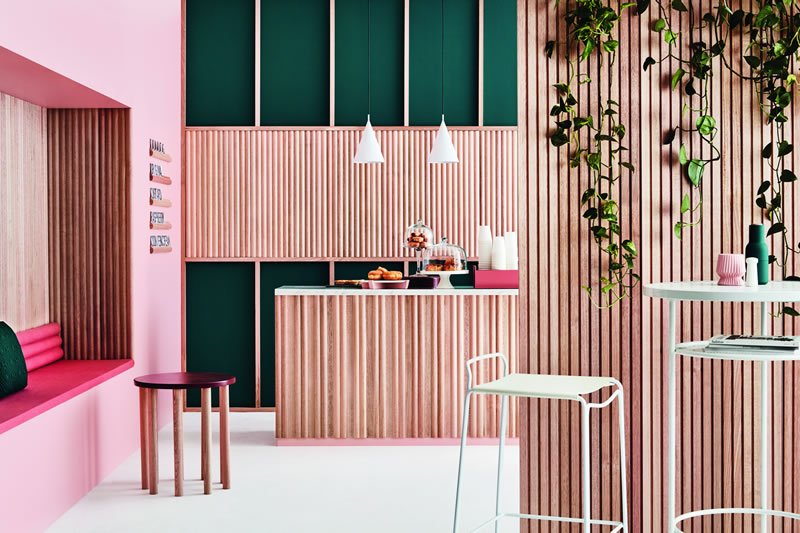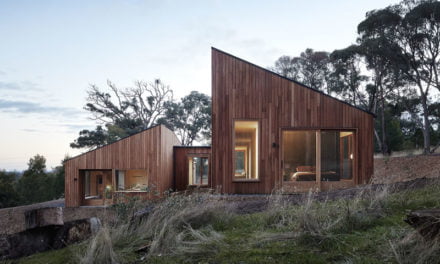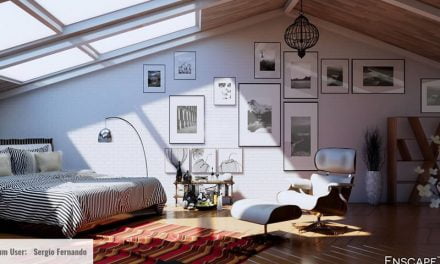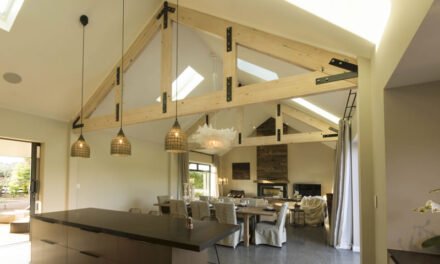Timber cladding ticks more boxes in terms of technical performance and aesthetics than any other. We talk to some of the biggest suppliers about what’s hot now.
Main image: Porta Contours celebrates the texture of Tasmanian Oak in Strata (wall), Riverine (back wall) and Plateau 39 alternating with Riverine (bottom counter). Courtesy Porta
Bear with me, I’m about to make a skin care analogy. If you’ve ever watched ads for moisturisers, they talk a lot about your skin being your body’s first line of defence when it comes to staying healthy. And if that’s not the focus, then it will be a thinly veiled suggestion that looking as young as possible comes with benefits. Unlike the promises made about what’s in the jar, these statements are both true, and they also apply directly to the skin of our homes.
Cladding, like a good complexion, is always pulling double duty. On the one hand it plays an important role in protecting the fabric of a building, insulating it from heat, cold and sound and prolonging the life of the structure behind it, whether external or internal. On the other hand, it’s a vital part of a building’s attractiveness.
One of the greatest strengths of timber cladding is how well it delivers on all fronts, and the extraordinary diversity of looks it can deliver. We spoke with several leading suppliers about what they’re bringing to the marketplace, what consumers want, and how they’re growing their ranges.
Sustainable options
“We have a lot of merchants and retailers demanding certification,” says Carmel Smyth, product and innovation manager at Porta. “It’s becoming more and more critical, and that’s being driven by both clients and specifiers.”
Depending on the timber, Porta’s range of individual decorative lining boards is either FSC certified or Responsible Wood/PEFC certified. “We source from a number of countries with trustworthy supply chains,” says Smyth. “For example, our Endure range which is an external product, uses a timber called Cumaru which is sourced from Peru. The Contours range, which is our internal lining range is produced primarily from Tasmanian Oak. We also make our timber linings in a number of different Australian species, which we source according to our customers’ needs.”
For external timbers in particular, easy access to product information is vital for customers. Obviously BAL ratings are essential for everyone in bushfire areas “and having achieved a higher BAL rating does mean you’re maximising your customer base on each product,” says Smyth, but the ability to withstand coastal weathering, or extreme temperature or wet – especially after this year – is also a vital part of matching the perfect product to a project.
“We put a lot of effort into testing and obtaining the relevant certifications from various bodies for that reason,” Smyth says. “So when we’re talking to our customers, we can guide them towards the best choice.”
The Cumaru used for Porta’s Endure range is a Class 1 durability timber with a 40+ years above-ground lifespan that can be oiled or coated or left to silver naturally. Available in a large range of standard profiles, it can also be milled to order, as can the interior Contours range. “We pride ourselves on being able to do custom work,” says Smyth. “Not just in our lining board ranges, but in our mouldings and other products as well. Sometimes we’re matching something from a photo, sometimes we develop it from a drawing. The request might come from an architect or designer, or someone coming into a store or sending their builder. We work with them to bring to life those custom orders.”
Which means there’s an enormous range of possibilities for how Porta’s timber lining boards are used, particularly in interiors. Bold and graphic designs abound in Porta’s lookbooks, filled with photos of recent residential and commercial projects, along with richly organic finishes that delight in timber’s natural colours and grain.
“I believe people are looking for texture and warmth in their home,” Smyth says. “For residential users, the Tas Oak internally and Cumaru externally really provide that level of interest from a visual and tactile perspective. Then, on top of that, are features that benefit your home: the natural acoustics and soundproofing that comes with using timber.
“Our commercial customers, who are a high growth group for us, are looking for something similar. All those physical benefits, but also it warms up the space and makes an impact. Especially with the natural timbers used in large, open areas – you get that wow factor when you walk into a space.”
Natural looks
The wow of natural timber is a major selling point but there are also definite trends. “Right now, blonde is big,” says Julia Hall, CEO McCormacks Australia. “We’ve recently introduced a new American Oak product that has a beautiful blonde look, which will grey off over time if you don’t want to preserve it with coatings. For people who like Australian Silvertop Ash, which is quite popular, but a little bit hard to get a hold of, the American Oak is a really good alternative.”
Imported from certified sustainable sources in the US, the cladding is profiled at the Heyfield Australian Sustainable Hardwoods (ASH) mill and supplied with an H3 treatment, so a coating isn’t necessary to ensure its 15-year guarantee against mould or decay.
“Though, of course,” Hall says, “if you want to keep the colour, you can use any kind of exterior oil. We’d generally suggest a decking oil or exterior clear, or you could varnish it, although that’s a big job when you come to redo it.”
Despite having only been on the market for a bit over a month, the American oak has already attracted significant customer interest. “And I think a lot of that is to do with how much it embraces its natural qualities,” says Hall. “It’s back sawn, which really brings out a beautiful grain that you don’t often see in cladding on the outside of a home.
“It’s not just that blonde timbers are in fashion and that grained look is very popular – I think it’s how humans react around timber. We have a real affinity with it, because it’s a natural product, it makes us feel really good. That’s why there’s so many more people choosing to have a timber feature wall or timber cladding on the outside of their home or any of those timber bits, we love it. We’re drawn to it. It’s part of our spirit.”
Hall points to data showing increased spending by customers in timber-rich hospitality spaces as proof that this sense of connection is tangible – “and a practical reason to look at timber when you are fitting out a business or a home!”
McCormack’s range of cladding timbers also includes Spotted Gum and Ironbark, as well as Silvertop Ash and IronAsh cladding. “That’s another ASH product with the H3 treatment,” says Hall, “and like the American Oak, you can choose to keep the colour with an oil or just let it grey off.
“The good thing with both these cladding products is that they’re end matched. That means we supply them in packs of random lengths, so that you don’t have an unwanted line on your wall where a set of boards end. And when it comes to fastening them together, they actually click in on the ends of each board, which makes it much easier for installation and much neater.”
Several of the McCormacks cladding products including IronAsh, Silvertop Ash, Spotted Gum and Red Ironbark have BAL 19 or 29 ratings. “Though in many cases, you need to have a non-combustible product sitting behind the cladding,” Hall says.
“We stock Magnum Board, which you can use in this application, or for higher risk areas, where you need a BAL 40 or BAL FZ product, you can use the Magnum Board weatherboard cladding. They’re not timber, but they are another natural product that holds carbon and they can stand up to floods as well as fires.”
Coated cladding
While natural is beautiful, variety is the soul of both commercial and residential architecture and over the past few years Thermory has responded to trends for colour and texture in cladding with a series of specialised ‘coated’ claddings.
Ignite has been available in Australia for a few years. With a colour and texture that realistically echo Japanese charred timbers (yaki sugi ban) without any risk of charcoal transfer or bleed, it’s a dramatic look that can be used internally or externally. The spruce timber is thermally modified – as are all Thermory products – to enhance its stability, durability and resistance to moisture, rot and pests. It’s then embossed, brushed and tinted to deliver all the beauty of charred timber, with none of the irregularity or mess.
In terms of celebrity endorsements, Ignite comes with one of the best: Snoop Dogg recently chose to use it on The Property Brothers’ Celebrity IOU. The rapper hand-selected it as the external cladding in the transformation of a garage into a luxury retreat for a friend who works as the youth commissioner for a football team that supports kids in the area Dogg grew up.
“It was so exciting for us seeing Dogg standing there in front of our cladding,” says Oksana Skorbatjuk, Thermory brand manager, grinning. “Our US distributor facilitated the whole thing, so they had a great close encounter!”
Closer to home, TV renovator Shaynna Blaze is also featuring Ignite in an upcoming renovation show on Channel 9, which was finalising at the time we spoke.
“It’s been extremely popular around the world,” says Maria Pirogova, area sales manager, “as has our Drift, which resembles recycled timber but with more predictable lengths, widths and colour. Now we’ve launched a new range called Vivid, which is available in three types of finish.”
Vivid Silvered comes in light and dark grey options, delivering an aged silver finish from the day the cladding is installed. “It’s for people who like that aged look,” says Skorbatjuk. “The coating will wear off equally and subtly over years, revealing the timber beneath it, which will by then have aged naturally, so you will keep the look without ever having to repaint it.”
Vivid Opaque has a coloured acrylic coating available in a range of bold and subtle tones. “The advantage of having this opaque coating over Thermory’s wood is the durability,” says Pirogova. “Because the wood under the coating is stable and doesn’t rot, the coating doesn’t lift from it. So the coating lasts longer, an average of 10 years before it needs repainting.”
The water-based paint is environmentally friendly but has gone through rigorous testing, especially in Estonia, where the company is based. “It’s performed beautifully in its trials in the Baltics,” says Skorbatjuk, “We haven’t had it in Australia for 10 years yet, but we know the wood beneath performs very strongly in your conditions and expect the paint will, too.”
Vivid Translucent has a semi-transparent coating that lasts an average of seven years and allows the natural grain to show through. Like the Silvered, it can be left to wear off over time or recoated, depending on your preference.
“The beauty of Thermory wood is that it’s your choice if you wish to have it coloured or oiled,” says Pirogova. “You don’t have to finish it. All Thermory products are naturally rot resistant, so you don’t have to coat them for durability, it’s just for aesthetics.”

Pirogova points out that most of the Thermory product sold in Australia so far has been Thermo Radiata Pine, like that used at Jack’s Point NZ in the image above. “We’re very excited about expanding what we offer in the local market,” she says. “Like those of us living in the Nordic countries that Thermory products come from, Australians love their timbers, so we’re happy to deliver more choices when it comes to colour and finish and even texture, with the knottier Nordic Pine available to you now, too.”
On the wall
As if the range of cladding options wasn’t extensive enough, then comes the question of how to put it on the wall. Vertical, horizontal, some of each, flat, gapped, ridged, even a mix of flat-sawn and rounded dowels – there are as many textural options as you can imagine, and that’s before you introduce colour and edging contrasts. Architects and interior designers have embraced the possibilities of timber cladding, with narrow boards forming patterns over extra-wide flat panels, shingles alongside boards, even specially milled wavy or patterned profiles.
Porta and Thermory both offer a series of inspiration galleries and publications, sharing many of their commercial and residential installations as a way to help inspire users, while McCormacks and other major suppliers like Kennedy’s Timbers use a mix of their websites, social media and magazines to share their recent projects (see ‘Green and glorious’ in last month’s TTN). Thermory has even produced a white paper titled Timber for Tomorrow: the benefits of Thermally modified wood in Australian construction to guide specifiers and architects in making their selections.
“It’s the versatility of the product that makes it so appealing,” says Porta’s Smyth. “Not just the many ways you can mix and match widths and profiles, but adding warmth, colour and tone to a specific space, and giving that visual texture and excitement to the eye. Every piece is unique. And with that uniqueness, you can get that subtle variation in the finish, the colour and the features of every single piece.”
Conversely, timber can also provide unity throughout a space. “If you’re working externally, you need something that’s versatile,” Smyth says. We offer Cumaru as more than just a lining board, you can use it for decking, for landscaping in the garden and it can all tone in together.”
Seamless finishes and hidden fixings are available directly from some suppliers, while others will make recommendations to your builder to achieve the desired result. Standard lengths average around 2.7–3.6m per board, though some suppliers will source longer boards as part of special orders.
“Our Contours timber lining range is all tongue and groove,” says Smyth, “so it fits very easily together. Depending on the type of wall installation, the edging finish can vary. You can simply trim the tongue section for a neat finish or use a piece of DAR quad. But, generally speaking, it’s easy to install and apply, and the design itself takes into account any slight movement with the timber.”
One point Madhuri Ranjan, commercial marketing manager for Intergrain Trade & Industrial makes is that, if you’re not using a highly durable timber like one of the above, or if you want to keep the original colour, coatings are necessary for external use.
“It’s the coating that protects the timber and makes sure you have the maximum product life possible,” she says.
“For some of those highly durable timbers, it’s an aesthetic choice. But for less durable cladding options, it’s a vital part of your home maintenance.”
Most of the reputable brands in the market will do the job well, but Ranjan emphasises the benefits of pre-oiling services where they’re available.
“We work with a lot of clients who are now pre-oiling for their customers,” Ranjan says. “It guarantees that the backs of the boards have a coating, which will last for a long time, as they’re protected from the level of exposure on the outer side.”
Intergrain has developed Uni Oil for exactly this purpose. “It’s an open system, so you can follow it with a water-based or oil-based finishing oil, depending on what the client wants, and it can be tinted as well,” says Ranjan.
“Best of all, it dries extremely quickly. I was just with a customer who showed me the cladding he’d coated in an oil-based product and it was still not dry, even after 24 hours. He told me that in winter, it can take a week or more. Uni Oil dries overnight. Particularly in the winter months, this is a huge benefit. As he said, ‘I get a faster turnaround and I can get the floor space back.’”
TTN will be running a special feature on pre-oiling options in our July edition.
Smyth says Porta offers a pre-oiling service for its Endure external products prior to shipping to site for additional coating. “It’s going to be there for a long time and you want it to look and be its best, whether you leave it with a clear coating to grey off or use a pigmented coating. By coating before you install, you get the best result. And while Cumaru is a very low-leaching timber, for some of the tropical timbers that are used as cladding, it can minimise their tannin run-off.”
Looks aren’t everything. In high rain areas (which is apparently almost everywhere this year) and regions that can expect regular snow, dimensional stability is vital.
“This is one of the major strengths of Thermory,” says Skorbatjuk. “Our product was designed to cope with climates that at times have very high moisture and then at others go very low. In Estonia, we have the heating season: during our winters we have very dry air in our homes, while outside, it may be dry or it may be snowing. In the summer, it’s more moist. Timbers that aren’t thermally treated start to gap between panels, because they don’t deal as well with these changing extremes. The very same product that does the job at my home in Tallinn in Estonia works every bit as well at your home in Sydney, or in Brisbane or Melbourne.”
Elsewhere in Australia, BAL ratings may be the driving factor behind a choice of cladding. “But there are still options available for people who want to build in the bush,” says Hall. “The spotted gum we source from Pentarch goes up to a maximum BAL 29, for example, and you can use other products like our IronAsh as part of a complete system with a non combustible product sitting behind it. So you may need to go through a few more steps, but if you want that timber look, you can usually still get it.”
Flexible supply
One of the benefits cladding has over structural timbers is that, as long as it meets the same design requirements (looks durability, BAL rating, strength…), it is much easier to substitute one option for another. Once you’re sure there is a performance match and the client is happy with the look, it’s a simple swap.
“Which provides us with a lot of flexibility,” says Smyth, “because supply issues continue to challenge the industry. The species we can source fluctuate regularly.”
Porta has dealt with this by diversifying its ranges. “We’re putting in place strategies to try and spread our linings and even some of our moulding products, into areas that are not taking advantage of a single species,” Smyth says. “We’re trying to mix up the species a bit to guarantee that continuity of supply, especially with the increasing demand that’s been happening over the last couple of years.”
It’s definitely not the worst problem to have in business, particularly when it’s arisen out of the success of industry programs. Smyth says: “We’ve seen a strong response to education around the importance of wood as a sustainable building material. The facts that it can be regrown, act as a carbon store and is a material that makes people feel in touch with nature make it a perfect choice.”
Accordingly, there has been growth in timber options being specified for custom-built homes and higher-specced homes from residential building companies. “Because it is a premium product,” says Smyth, “we have a strong group of commercial customers, who are seeking timber lining more and more. They’re using it in a lot of their builds, whether that’s apartments, hospitality venues, offices; you name it, it’s being used. So it’s very popular and the demand is increasing.”
Shipping from Europe hit the same Covid bump for Thermory as for everyone, but is back on track now.
“Our distributor in Australia stocks Ignite and Drift at the moment, and we hope to have Vivid in Australia shortly,” says Pirogova. “We have an advantage with timber supply: the forests we source from across Europe and the US and our forestry operations are big enough to be resilient when it comes to demand surges, so we can concentrate on expanding what we’re supplying into the Australian market for people who are looking for the benefits of our product.”
Hall has also felt the strength of the market. “Everybody wants timber cladding at the moment,” she says. “If I had double the stock I have, I could sell it all. No problem whatsoever. Which is also why the American Oak is so key, because it does actually fill a gap in supply while some of our Australian sources are recovering.
“It means that people can keep that precise look that matters to them, without having to wait.”
Hall jokes that it sounds a bit Instagram, but is entirely serious when she says that one of the key marketing tools for cladding in recent years has been through Facebook. “We have two main channels: industry and consumers,” she says. “The industry side is architects, designers and builders; and they mostly come to us in traditional ways.
“But a lot of consumer engagement has come through our Facebook page and our website, especially around Magnum Board and the American oak.”
It’s been a real change for the McCormacks’ team, giving them an opportunity to talk directly to consumers. “What that means for us is that we get direct, free feedback on our products,” Hall says. “So when we get a lot of hits and a lot of engagement around a product, we know this is something the public wants. Usually, as a wholesaler, it’s very difficult, because we sell to a hardware store that then sells to a consumer or a builder. We’re twice removed.”
The Facebook page hasn’t only helped McCormacks test the market on new products and features, it’s also helped their customers. Hall and her team take rotating shifts to cover queries and reply quickly.
“Mostly people want to know where they can purchase the products or who has it on the shelf or a rough guide to pricing, so they can go, ‘OK, this is actually in my budget!’,” Hall says. “Having that granular information on our website has been really important because it means the consumer can actually check and see if we’re offering the right profile, length and so on at a price they can afford. That really empowers them. They can make a quick decision and push their builder whichever way they want.”
For more information, visit www.mccormacksaustralia.com.au, www.porta.com.au and www.thermory.com











